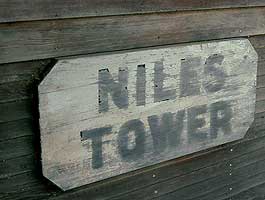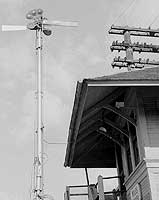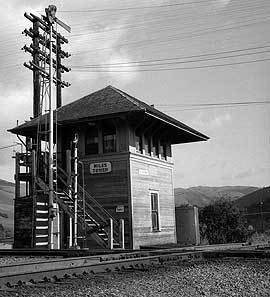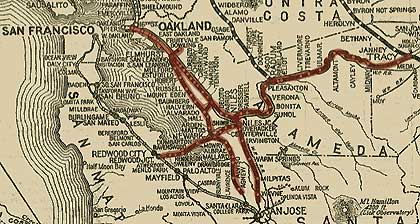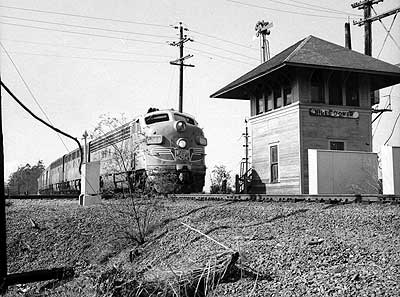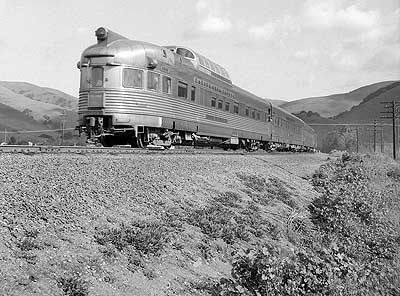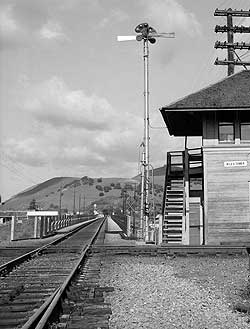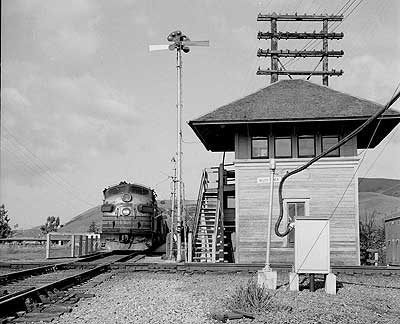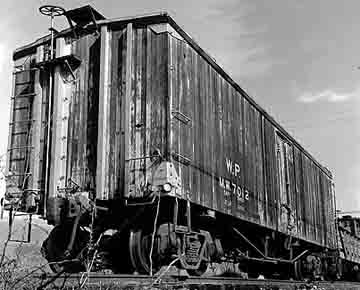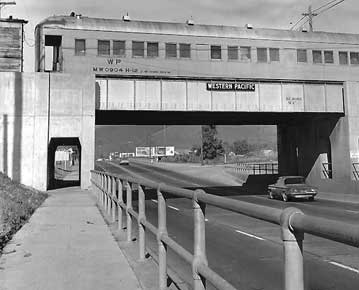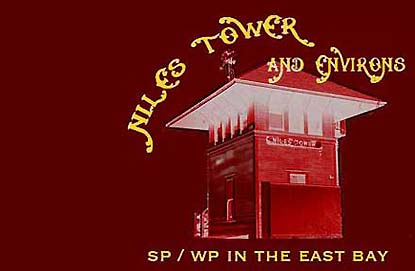
For the next three years, the silent screen's first true star, Gilbert - better known as "Bronco Billy" - Anderson starred in hundreds of one-reelers shot in Niles and nearby Niles Canyon. A young comic, Charlie Chaplin, signed-on in late 1914, and filmed his defining movie, The Tramp, here (also under contract: Wallace Berry, Chester Conklin, Ben Turpin and Zasu Pitts). Chaplin and Anderson moved-on a year later, however, and the studio closed in early 1916.
In contrast to the major doings at Essanay, a comparatively minor event took place earlier in 1912, just across Alameda Creek from the studios: Western Pacific erected Niles Tower. The tower's construction probably evoked slight commentary from other than sidewalk superintendents, since the hullabaloo connected with WP's inauguration had taken place two years earlier. But no matter that it arrived late and was no technological wonder like the motion picture, the tower would soldier on for half a century after talking movies supplanted the silent screen. It was only in its last years that Niles Tower gained any notoriety at all - this from railfans and a few historians who realized that the old dinosaur's time was about up - that standard technology of 1912 was ancient technology in 1980.
Niles Tower finally succumbed to SP's implementation of CTC and DTC in early 1986 (and was cremated in two successive fires later in the year). Although WP operators manned the tower (as part of the agreement allowing WP to cross SP tracks), most of their work involved SP - related duties: cutting orders and routing trains around SP's two wyes. Their WP work was largely confined to 'sparking-up' the WP signals guarding the SP/WP diamond. The tower's interlocking machine did not connect with the switches at WP's Niles Junction and operators did not cut WP train orders.
Though the tower operators' work was one-sided, they nevertheless had plenty to do, for Niles was (and is) a busy place. Long before interlocking towers became peculiarities, Niles was a natural railfan gathering place. Here they could SP/WP freights off of the Altamont being routed to Oakland, San Jose or SP's Bayshore Yard. Bayshore/Mission Bay-Oakland SP freights and San Jose - Oakland traffic on both railroads also passed the tower, and a considerable number of local freight trains called as well. Even well into the diesel years, SP ran helpers on many Altamont trains - which meant a considerable number of light engine moves around Niles.
An interesting aspect of the tower was how it functioned as an integral part of what you could operationally call a (widely-spaced) multiple main track arrangement between SP's two Oakland - San Jose lines. Between the two cities, extra through freights could operate on the Mulford/Santa Clara or the Decoto/Milpitas lines in either direction: for instance an RVWJY might operate on the former route, while an RVWJY following ten minutes later might be dispatched past Niles Tower on the later route. The Centerville Main, between the tower and Newark added even more flexibility, for it was used as a giant crossover between the two north-south routes. The only routing that was little-used was the Milpitas - Centerville - Mulford one, because trains were forced to stop at the east leg of the Centerville Wye for their brakemen to throw hand-operated switches.
In the tower's last years, after WP and Santa Fe had both discontinued trans-Bay car barge service, Shinn siding became a major interchange point for WP cars bound for San Francisco. In the Summer of 1979, Wx4 staff picked up a 110 car,11,000 ton unit grain train at Shinn...with two SW1500's. The engineer managed to get enough of a roll on the train to make it to Bayshore Yard without falling down, although the major mountains at Dumbarton Bridge, Belmont and Millbrae were pretty dicey. In this case, WP accomplished the SP transfer by shoving the train to clear the east switch at Shinn. The tail end must have been somewhere past Niles depot. Cuts that would clear between Shinn's switches were usually pulled out of WP's yard and shoved into the siding.
The only thing largely missing at Niles was passenger trains. SP discontinued its Stockton / Fresno service and confined its Oakland - San Jose local passenger trains to the Mulford line just prior to World War II. Post-War, WP never ran more than two passenger trains each way per day, and only the California Zephyr by 1960. (See ____ for timetables, tonnage ratings and SP train orders)
With the coming of the recession and transportation deregulation in 1980, soon followed by SP's closing of the Altamont and Dumbarton lines, Niles Tower slumbered through its final years - area traffic did not radically pick up again until the coming of Amtrak's Capitol trains after the tower's demise.
We wish that we had spent more time railfanning at the tower - we only made four brief trips between 1965 and 1983 - but its dour, weather-beaten exterior was a familiar sight to us in the 1970's and 80's, as we snatched train orders off of its hoop from passing pool and local freights. We miss the old girl, for to us she meant better times.

Bronco
Billy
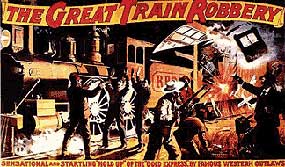
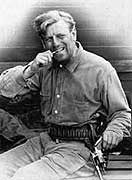
Loco Tonnage Ratings:
Train Orders:
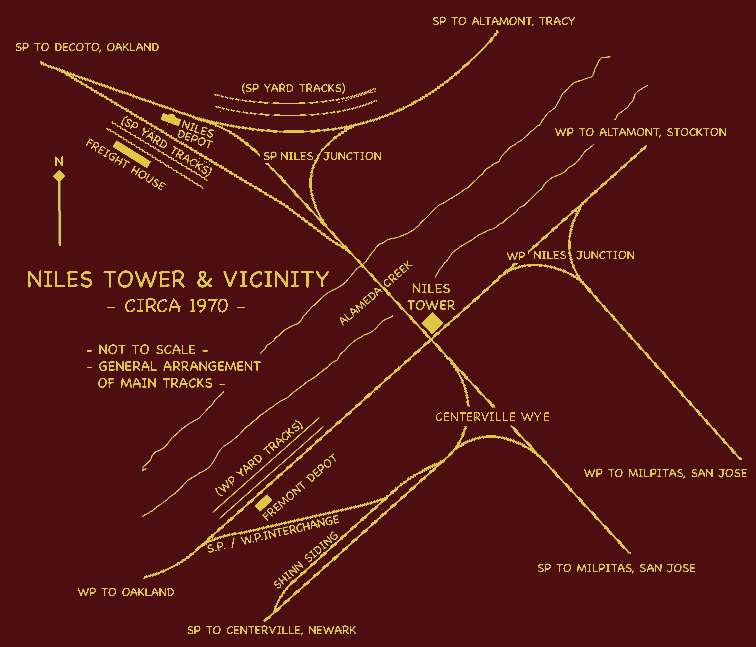
Above: the general layout of main tracks near Niles Tower about 1970. The tower's interlocking machine controlled the switches at SP's two wyes, except for the was east leg of the Centerville Wye, which had hand throws at both ends. WP's Niles Junction was CTC controlled by the dispatcher, not the tower operator. Likewise, the operator only hooped orders to SP trains. The WP operator's only 'hand-on' dealings with his/her own railroad were limted to controlling its signals over the diamond. Thus, when SP went to DTC and CTC, the tower was finished.
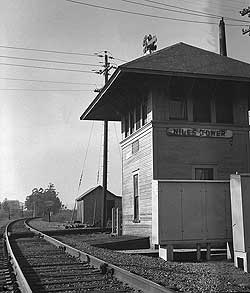
January, 1965: A First Acquaintance
My father was a passing rail buff, who regaled me with stories of riding the South Pacific Coast narrow gauge to summer camp at Mount Hermon, amongst other tales. His real passion, though, was Western books and movies, and one day he told me that he had met Bronco Billy Anderson "back when they used to shoot movies in Niles Canyon". I had never heard of this, so he suggested that we go up and scout the place, further sweetening the idea with the mention of "lots of trains". Thus, we see my first image of Niles Tower, above. It was developed by a young friend who botched the job, so I spent 45 minutes Photoshopping the darn thing to make it presentable. Somehow the result has more of the feel of the tower 50 years earlier, when dad met Bronco. Dad had hoped to show me the location of his meeting, but he sadly found that the old Essanay movie lot was long gone. - E.O.
Below right: a short time before the CZ appeared, SP F7A #6468 leads a train from Tracy towards Milpitas; consist - F7A/C628/DRGW F7B/C628.
Below left: Why We Don't Have Any Photos of the North Side of the Tower - It never occured to us to ask the operator if the bridge over Alameda Creek would be clear of trains long enough for a shot. In this case, the X6468 came rumbling over the bridge about five minutes after this shot. We included this photo, and the underpass photo below, for you Niles/Fremont folks. The landscape surely looks vacant, compared to today, yes?
